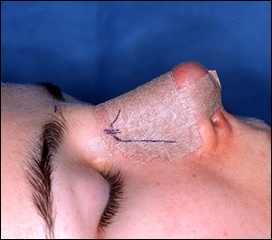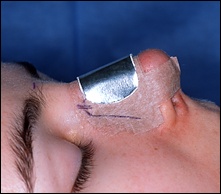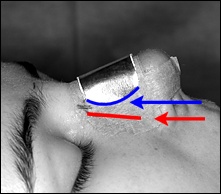
- Incisions

- Hump removal

- Nasal septum

- Tip narrowing

- The nasal bones

- Splint

- Tip support

- Shorten the nose

- The nasal spine

- Revision surgery

- The nasion

- Odd cartilages


|
| Image size: small show larger |
|
After placing the tape, I re-drew the purple lines on the side of the nose that show the osteotomy tracts. We'll want to see those lines when the metal splint is placed. Note that this nose might look a little shorter after taping than before. I place the tape tightly, and the tight tape often torques the tip of the nose upwards. The tip will eventually fall back to its normal position. The tight tape at the tip can make the tip of the nose look more narrow as well. However, the surgeon should not expect the tape to accomplish something that he failed to accomplish during surgery. It won't. The tip may look more narrow or the nose shorter after it is taped, but the only changes in appearance that will persist are those changes that were made with scalpel and forceps, not with tape. |
| Click on any image in this tutorial to see a greatly-enlarged version |


|
|
Note that the lowest edge of the splint (blue line and arrow in the diagram above right) is above the location where the nasal bone was cut (red line and arrow). Stated differently, the splint isn't so big that it comes down to cover that red line of the bone cut on the side of the nose. Very important. We'll discuss why shortly. |
| Clear all red checks in the Rhinoplasty Tutorial |